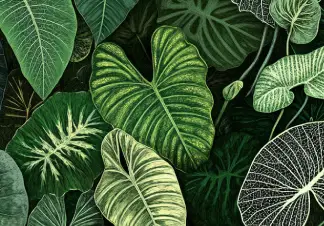Ficus elastica varieties: the complete rubber plant pokedex
If you've ever admired a tall, glossy-leaved plant in someone's home, chances are you were looking at a Ficus elastica, commonly known as the rubber plant. These striking plants have been gracing our homes for generations, and their popularity continues to grow.

ficus elastica
From jungle giant to living room star
In their natural habitat, rubber plants are impressive specimens. These Southeast Asian natives can reach massive heights of 30 meters (100 feet), starting their lives as epiphytes high in the forest canopy.
Their most striking feature? Those thick, leathery leaves that look almost artificial. Each leaf unfurls from a red sheath, with a glossy surface that reflects light - a feature that helped them shed tropical downpours in their native jungle homes.
Their latex-rich sap was traditionally used by indigenous peoples for waterproofing and medicine, and later became a source of natural rubber – though not as commercially successful as its cousin, Hevea brasiliensis.
While the classic Ficus elastica is beautiful, it's actually rare to find the original species in homes today.
The reason is simple: a tree the size of a house isn't practical for most living spaces.
This is where cultivars come in – carefully selected varieties that offer the same beauty in more manageable sizes.
The classic cultivars: The OG house favorites
Robusta: The standard bearer

ficus elastica 'robusta'
Robusta represents the classic rubber plant in a more manageable form. It features those signature leather-like leaves but in a more compact growth pattern.
This is typically what you'll find labeled as "Ficus elastica" at garden centers, and it's become the new standard for good reason.
Decora: The statement maker

ficus elastica 'decora'
Decora builds on Robusta's foundation with bigger, broader leaves that enhance its tropical appeal. Its generous leaf size makes it particularly effective as a focal point in any room.
The new cultivar generation
It's worth noting that the world of Ficus elastica cultivars can be quite complex. Many commercial brands and nurseries develop and market their own varieties, often with similar characteristics but different names.
In this guide (and our website), we've grouped cultivars based on their main shared features rather than brand names, as this proves more practical for identification and care purposes.
Some varieties may be sold under multiple names depending on your location or supplier - this is particularly common with newer cultivars as they enter different markets.
Sophia or Chloe: The round one

ficus elastica 'sophia'
Sofia offers a distinctive take on the classic rubber plant form with its rounder leaves and compact growth habit. Its softer silhouette provides an interesting alternative to the typical rubber plant shape.
Melany: The mini-tree

ficus elastica 'melany'
Known also as Melany Petit, this variety represents a breakthrough in rubber plant breeding. Its naturally branching habit, compact growth, and smaller leaves make it particularly well-suited to modern homes.
The balanced proportions of this variety have made it increasingly popular among plant enthusiasts.
The dark lords!

ficus elastica 'burgundy'
Also known as Abidjan or Black Prince, this variety features deeply colored leaves that appear almost black in certain lighting conditions.
While there's some debate about the subtle differences between these dark varieties, their rich coloring adds a sophisticated touch to any space.
The variegated selection
Tineke: The classic variegated

ficus elastica 'tineke'
This variety showcases striking cream and green variegation, with new leaves often displaying pink to reddish hues. These rosy tones typically fade as the leaves mature, leaving behind the characteristic cream and green coloration.
Sylvie: The tineke with more cream

ficus elastica 'sylvie'
The border of the leaves display a thick cream color, with some leaves ending almost white. Originated from a mutation of the Tineke, this one is patented since 1993.
Ruby: The colorful standout

ficus elastica 'ruby'
Ruby, also known as Red Ruby or Belize, features stunning red variegation that holds better than the Tineke cousin.
Fun fact: The Belize cultivar is patented (USPP16374P2). A patented variety means you can't legally propagate and sell it without permission from the patent holder - a testament to how valuable these unique colorations are in the plant world.
Shivereana: The maxi-variegated one

ficus elastica 'shivereana'
This variety stands out for its more organic-looking variegation patterns that resemble more usual leaf variations (like on the Monsteras !).
Sometimes marketed as Moonshine (particularly when showing intense variegation), Shivereana can produce leaves with patterns ranging from subtle marbling to dramatic full-white sections.
This unpredictable variegation gives each plant a unique character, making it particularly appealing to collectors who appreciate more natural-looking variegated patterns.
Doescheri: The subtle blend

ficus elastica 'doescheri'
Similar to Tineke but with more elongated leaves and a less dense growth habit, Doescheri often displays subtle golden tones in its variegation. The spacing between leaves creates a more natural, flowing appearance.
Pink Camouflage : The new one

ficus elastica 'pink camouflage'
The stunning foliage emerges with rich dark brown-green tones before maturing into an elegant dark grey-green with subtle pink undertones. This eye-catching variety features a unique camouflage-like pattern similar to the Tineke. This stunning variety was developed in the Netherlands, receiving official European plant rights in 2023 under the code name 'ESPE2006'.
Pro tips for care
These plants require regular maintenance to maintain their appearance.
Their large leaves collect dust easily, so regular cleaning is essential for both aesthetics and plant health. A gentle wipe-down every few weeks keeps leaves looking fresh and helps maintain efficient photosynthesis.
Exercise caution when handling these plants, as their sap can irritate skin and stain clothing. Always wear gloves during pruning or propagation activities.
Regular pruning helps maintain an attractive shape and promotes branching. As plants age, they may lose lower leaves, but strategic trimming can help maintain fullness and prevent leggy growth.
Do not hesitate to cut! They are very resilient.
Want to dive deeper into specific care tips for each variety? Check out our detailed care guides for each cultivar!
